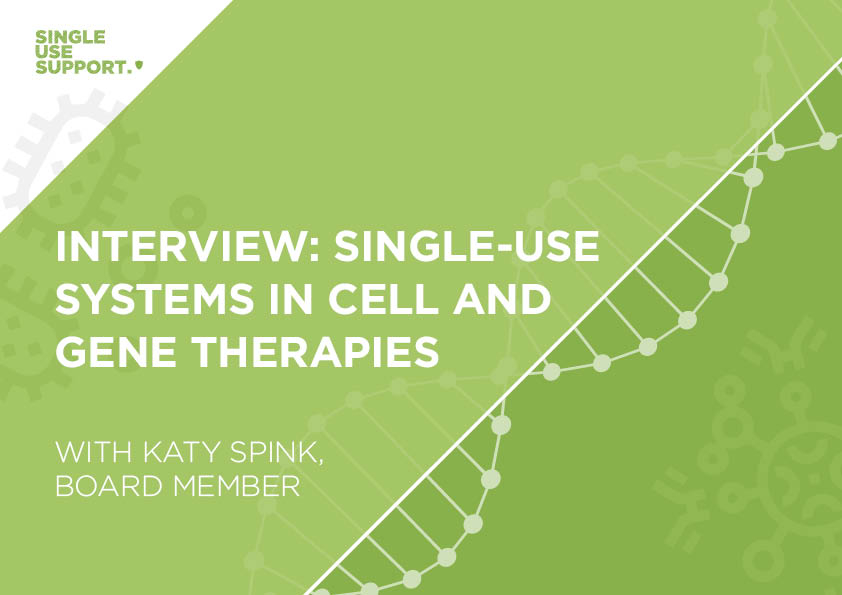February 20, 2022
Interview: Single-Use Systems in Cell and Gene Therapies with Katy Spink, Board Member
Katy Spink is Single Use Support’s newest board member. In order to further grow our expertise in efficient solutions for fluid management and innovative logistic solutions in the cell and gene therapy sector we asked Katy for her professional insights on topics including the usage and future of single-use systems in the space of cell and gene therapies.
In addition to being a board member at Single Use Support, Katy is Chief Operating Officer and Managing Partner at Dark Horse Consulting Group, a consulting practice fully focused on the cell and gene therapy industry. She has spent the past 20 years in leadership roles in the development of cell and gene therapy products. Prior to joining Dark Horse in 2018, she spent five years as Chief Operating Officer at Asterias Biotherapeutics, a publicly traded cell therapy company in the San Francisco Bay area. From 2003 through 2011, Katy held various leadership roles at Geron Corporation (an early mover in the cell therapy space), including serving as a key member of the team that led Geron to the first ever FDA approval for initiation of clinical trials of a pluripotent stem cell derived product. Prior to Geron, Katy was a management consultant at McKinsey & Company, advising clients in the pharmaceutical, biotechnology and medical device industries on matters of R&D, marketing and business development strategy. She holds a Ph.D. in cancer biology from Stanford University, where she was a Howard Hughes Medical Institute Predoctoral Fellow.

In what specific area of the of the CGT manufacturing processes do you see the best usability and the highest potential for implementation of single-use systems?
I think across the entire space, there's actually quite a bit of need for the types of systems that Single Use Support is developing and implementing. For example, ensuring that cell and gene therapy products are shipped at cold temperatures with robust controls is, if anything, even more important for this class of products than it is for more traditional biopharmaceutical products because they are complex biological systems and you really don't want to take any risks of them being disrupted during storage and shipment.
"The use of single-use systems is particularly important for cell and gene products because maintaining sterility and the aseptic nature of processing is so critical."
Katy Spink - Board Member
Also, I think the use of single-use systems is particularly important for cell and gene products because maintaining sterility and the aseptic nature of processing is so critical. For a cell therapy product you can't do sterile filtration at the end of your manufacturing process, so integrating aseptic processing into every stage of manufacturing is far more critical compared to, for example, monoclonal antibodies where you have the benefit of being able to do a sterile filtration step at the end.
Do you see the application of single-use systems to be of the same importance throughout all individual manufacturing steps of cell and gene therapies or would you consider it to have an increased advantage in one process step compared to the other?
When looking at the RoSS system as an example, I think there are robust applications both upstream and downstream. For example, in an autologous CAR-T process, the initial leukapheresis product that you're taking from the patient and shipping to your manufacturing site is a critical starting material that's entering into your process at the very upstream part of your manufacturing process. And one thing that I'm really intrigued by is the potential to improve the reliability, reproducibility, and robustness of that shipping process using RoSS. Because it is a patient-specific raw material it is incredibly precious (in fact, close to irreplaceable), so it is critical that it not be damaged or destroyed during shipping and that its quality is maintained at the highest level.
Similarly, once the CAR-T product has been manufactured, it needs to be returned from the manufacturing site to the point of care for the patient, and arguably it is even more precious at this stage since a patient life hangs in the balance. Therefore, ensuring the highest possible control of shipping conditions to maintain product quality during that return shipment is also critical.
So, that's just one specific example to say that I don't see single-use technologies be applicable to only on one or the other stage of the CGT process. There are pretty robust use cases for single-use system products at both the most upstream and the furthest downstream steps of cell and gene therapy manufacturing processes.
Gene therapy is a much younger field when compared to for example protein or monoclonal antibody therapeutics. Why do you think that single-use technologies are established as a standard in this area?
It's a few different things. First, since these processes are younger, they've had the benefit of being able to adopt these newer technologies during their development processes. Given that, and combined with the relative importance of aseptic processing as I described earlier, I think it has just made sense for developers to gravitate towards single-use systems in designing their processes.
An additional factor is that cell and gene therapy processes are typically not operating at the very large scales of some more traditional processes. For example, typical monoclonal antibody facilities are operating at a scale of hundreds to thousands of liters, whereas many cell and gene therapy processes operate at a fraction of that scale, making those processes more amenable to single-use systems as opposed to, for example, the large stainless stirred tanks of older manufacturing processes.
In terms of the usage of single-use systems would you say cell and gene therapies are influencing the whole Pharmaceutical industry by demonstrating their benefits?
I almost think it's the other way around. Newer, more modern biopharmaceutical processes that are being developed have already been migrating towards single-use systems. And cell and gene therapies are building on the back of that. There are a lot of things that are different about cell and gene therapy manufacturing, but there are also a lot of things that are the same. For example, to make a monoclonal antibody, you grow cells, harvest the cells, and purify the antibody.
When you think about cell therapy manufacturing, the process is very similar: you grow your cells using, in many cases very similar processes, and the only difference is that now the cells themselves are your product rather than the protein that they've been harnessed to produce. And for a viral process it's even more similar because you're just harnessing the cells to produce your virus instead of a protein.
Cell and gene therapy manufacturing processes very much benefit from the learnings of best practices around cell cultures that have already been developed in other areas of biopharmaceutical manufacturing.
Katy Spink - Board Member
So the basics of cell cultures are the same across all types of processes and the difference is basically, what are you harvesting at the other end of that process and purifying and formulating and filling? In light of that, I think cell and gene therapy manufacturing processes very much benefit from the learnings of best practices around cell cultures that have already been developed in other areas of biopharmaceutical manufacturing.
What is your advice to manufacturers considering implementation or ramping-up single-use systems?
One thing that I always recommend to my clients in designing a manufacturing process is beginning with the end in mind. What I mean by this is to be sure that you understand what the ultimate goal is with respect to your manufacturing process.
This can take different forms for different products, but let’s consider the case of an allogeneic cell therapy product. For an allogeneic product in early clinical trials, you may only need to be manufacturing product for tens of patients in a year, but you want to make sure that the manufacturing processes that you have developed has a clear path to scalability to where you want to be at your commercial scale, which, depending on the indication that you’re going after, could be thousands or even tens of thousands of patients.
More about scalable Freeze-Thaw and Fill-Drain platforms from Single Use Support
I think that has a few different implications: one is, at what scale does your manufacturing process ultimately need to be able to operate in order to make it manageable in terms of the number of manufacturing lots you need to make per year for that product? Typically you may be aiming for something in the low tens of manufacturing lots per year, so if you're aiming to make product for tens of thousands of patients, that can be a pretty large scale manufacturing process that you need to be able to achieve. You need to think about what that vessel looks like and is there an appropriate scale down model that you can be using today to enable you to get to that with minimal comparability risk and technical risk for scale up.
And then the other thing that comes into play for cell therapy products in that calculation is making sure that your cells are able to undergo the number of cell divisions that is required to achieve that scale, without impacting the critical quality attributes of your product. So even when you're not manufacturing at that large scale in an early clinical stage, you need to be sure that you are still testing the robustness of your process with late passage cells so that you don't hit an unexpected roadblock later when you scale up.
What are your goals and expectations for the future development of and with Single Use Support?
My goal… is to work with the management team on the exciting list of products that you have at the company and in doing so, to address some of the remaining unmet needs within the cell and gene therapy space.
Katy Spink - Board Member
My goal in joining the board of Single Use Support is to work with the management team on the exciting list of products that you have at the company and in doing so, to address some of the many remaining unmet needs within the cell and gene therapy space for these types of products. I believe the Single Use Support products have great potential to improve robustness and reproducibility of manufacturing processes within the space.
Find out more about the product solutions Single Use Support for cell and gene manufacturing:


